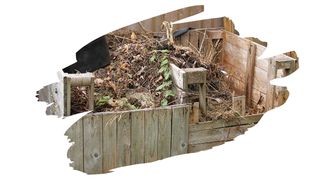Like all natural materials, wood has a limited shelf life. If you don’t use raw wooden boards or firewood fairly quickly, rot can begin to eat away at them.
But, what if you have some very old logs lying around? Or maybe you’ve replaced some rotten wooden beams in your home…and now you’re wondering what to do with them.
They’re clearly too far gone to save—but does rotten wood always need to be thrown away?
Well, in this post, you’ll discover if rotting wood can be saved…or if it’s always done for. We also explain why treated wood should never find it’s way into a compost bin.
You will also learn why you should use a compost bin to turn rotting wood into mulch…and never leave rotting wood to decompose outside on the ground.

This post may contain affiliate links to products that we receive a commission for (at no additional cost to you). Learn more here.
What Can You Do If Wood Is Rotting Away?
You can try and save it by stabilizing it with wood hardener. Wood hardener will preserve the integrity of the ‘healthier’ parts of a wooden beam.
Any parts that are beyond repair, (i.e. it crumbles away in your hand), can be replaced with wood filler.
Now, saving rotting wood is worth it if it’s happening in key areas, (such as the kitchen or bathroom). Yet, when it comes to old fire wood, it isn’t worth spending time and money trying to restore those logs.
Can You Do Anything Else With Rotten Wood (That’s Already Rotted Beyond Repair)?
Yes, absolutely. The main thing that comes to mind is composting. Wood, is a natural material. And out in the wild, a felled tree would become mulch for the soil around it.
So, untreated natural wood (i.e. wood that has not been treated and infused with preservatives or chemicals), can be great for composting.
Can You Compost Any Kind Of Rotting Wood?
Yes you can, as long as that wood is natural, untreated, and free of chemical preservatives.
So that means, do not try composting pressure treated wood. This type of wood is packed to the brim with wood preservatives. And those preservatives are more likely to do more harm than good, if they get into your soil.
It also means engineered wood types, (such as Plywood and OSB), are a no-go as well. Why? Well, because these manufactured materials are filled with glues and chemical adhesives. And this makes them equally unsuitable for garden soil.
Is Rotting Wood Good For The Garden? Can I Just Bury Wood In My Garden?
You could, except for the fact that rotting wood can drain top soil of nitrogen.
Here’s the thing; as wood decomposes it sucks up a lot of nitrogen. That’s because rotting wood uses up a lot of chemical element as it breaks down. Particularly during the early stages of decomposition.
As a result, rotting wood can end up leeching a lot of nitrogen from the soil around it. So much so, that any nearby garden plants won’t be able to get enough nitrogen from the soil for themselves.
Now, this doesn’t last forever, of course. Once wood has completely decomposed, it returns all of that nitrogen back into garden soil. But, until then, you may find that nearby plants aren’t growing as healthily as they should.
That’s why you’re better off letting rotting wood decompose in a compost bin. This way, it can go through its nitrogen-rich decomposing process, far away from your garden plants.
Still, if you don’t want to pay for a compost bin, then make sure you bury wood deep into the ground. It needs to be buried deep enough so that it’s not taking much (if anything) from that nitrogen-rich top soil.
Which means, you will want to bury that rotting wood at least one foot into the ground, (since top soil is anywhere between 5 inches to 10 inches deep).
Related Post: Should You Really Try Hot Composting Wood Chips?
What About Using It As Firewood? Is It OK To Burn Rotted Wood?
No, not really. Not if you want that firewood to burn hot enough and long enough to heat your stove or your home.
Rotted wood has a much lower density than rot-free lumber. And since it has less density, there is simply less of it to burn. That means that it won’t burn for very long (or as hot).
Related Post: Is Rotten Wood Good Enough For Firewood?
Also, decomposing wood will produce more smoke due to the moisture content in it. Ideally firewood needs to be dry before you throw it into the fireplace. That is because firewood will produce an excessive amount of smoke if it still contains moisture or sap.
Now, rotting wood has more than a bit of moisture in it, (hence the rot in the first place). So, rotting wood on a fireplace is going to emit a lot of lung-burning smoke and eye-watering creosote.
What Is Creosote? When wood burns it produces a black tar substance. This black tar is called creosote. However, creosote can also be found in wood smoke as well. Creosote is highly carcinogenic, and not something you want to be breathing in.
To Wrap Up, Here Are The 3 Key Takeaways From This Post…
- 1). Rotting wood can be saved by using wood hardener to reinforce the sections that have not succumbed to rot.
- 2). Otherwise, you can use untreated rotted wood as composting mulch.
- 3). It’s best to compost rotting wood in a compost bin. If wood decomposes outside, it can leech too much nitrogen from top soil.
References:
The Creosote (Prohibition on Use and Marketing) | Legislation.gov.uk
Topsoil | Wikipedia.org
